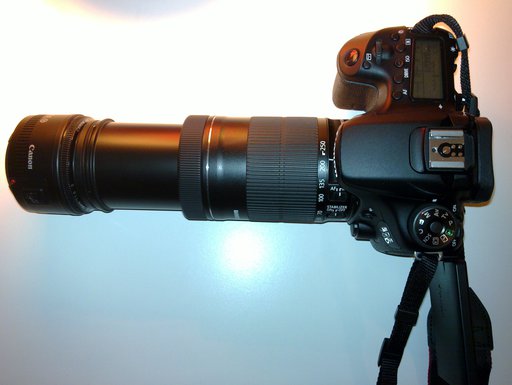Having recently come into possession of a DSLR, and with the weather being like this (i.e., wet), I've been thinking up what kind of photos I could take, at home, that I couldn't have taken with the old non-interchangeable lens camera. One such category is macrophotography with a reversed lens mounted in front of a regular one.
To summarize, the idea is to take a telephoto lens, a second lens with a shorter focal length, and connect the two with an adapter ring that attaches to the filter threads of both lenses. Allegedly, this should result in a magnification that is approximately equal to the ratio of the two lenses. For my pair of lenses (Canon EF 55-250mm f/4.0-5.6 IS STM and Canon EF 50mm f/1.8 II), that should theoretically be anything from 1.1x to 5x. However, only the far end is really usable, so the magnifications are... large. By way of comparison, a "regular" macro lens has a magnification of 1.0x, and non-macro lenses typically range from 0.1x to 0.4x.
(This is just one of several ways of doing "DIY" macrophotography without a dedicated macro lens. Other ways include things like extension tubes or mounting a reversed lens directly on camera. For details, see your favourite search engine.)
so does it work in practice?
The 55-250mm lens has a 58mm filter thread, while the 50mm has a diameter of 52mm. Reverse rings are available for all kinds of size combinations, but thinking of potential future filter use, I ordered a 52mm/58mm step-up ring and a 58mm/58mm reverse ring for a couple of dollars from eBay. Of course one of them (the step-up ring) arrived all bent out of shape and with a dent in the threads, so I was forced to try out the concept with the kit lens (Canon EF 18-55mm f/3.5-5.6 IS STM) in place of the 50mm prime. The resulting combination was really unwieldy, and had a lot of very bad vignetting at all possible focal length settings, presumably due to the small aperture of the 18-55mm lens.
After getting a replacement step-up ring... well, the combined lens pair is still really unwieldy (though not quite as bad, since the 50mm is significantly smaller and lighter), has vignetting except when the 55-250mm lens is set to >200mm (meaning a lower bound of >4.0x for magnification), and only focuses at working distances of around 3-5cm. The depth of field is ridiculously narrow, even with the 55-250mm stopped down all the way to f/32. So it's in no shape or form a practical device. The resulting image quality (whether due to difficulties in focusing, or diffraction from the f/32, or something else) also leaves something to be desired. It's undeniably fun, however.
Based on some back-of-the-envelope calculations, I believe the system is capable of resolving detail in the scale of 5 µm, so calling the contraption a "macro lens" is perhaps a bit misleading. Theoretical lower bound derived from field of view, distance of the plane of focus and sensor resolution is somewhere around 0.9 µm, but that's patently ridiculous.

Camera, lens, another lens.
first sample images
I've uploaded these to my flickr "Macrophotography" set.
That's a tiny Raspberry Pi resistor and capacitor; surface of a flexible safety reflector; and a dent in a step-up ring, respectively.
to be continued...
What next?
Well, there are some 1960s M42 screw mount manual focus lenses (Super Takumar 1:2/55, Super-Multi-Coated Takumar 1:2.5/135) complete with an extension tube set that I might get to borrow. Combined with a cheap M42-to-EF adapter, that might be a nice way to get macro shots that are a bit less... macro.
Will continue the series with a "part 2" if that ever happens.
